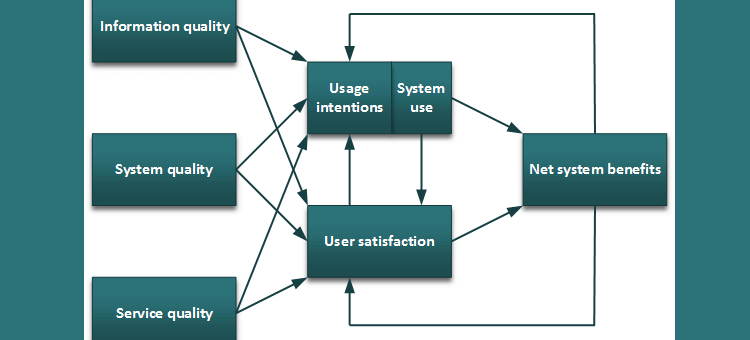SUMMARY OF MODEL
Measuring effectiveness of information systems was difficult until the Delone & Mclone’s Model for information system assessment came along. This model examines all the dimensions of information systems and categorizes all aspects that play a part in evaluating them.
Delone & Mclone’s model consists of six brackets that assess a few quality indicators under them. These indicators are connected to each other and do have some level of inter-dependence. The six divisions are system quality, information quality, service quality, intention to use, user satisfaction, and net benefits.
SYSTEM QUALITY
Parameters Assessed
System quality bracket in Delone’s framework assesses parameters of systems in places such as ease of use, user-friendliness of the system, security, and responsiveness of the system.
For Call Centers
System quality measures certain operational factors of the system such as the availability of the system to provide services 24/7, the reliability of system’s infrastructure and intelligent call routing to provide customers the ultimate experience.
INFORMATION QUALITY
Parameters Assessed
The information presented by the system is assessed to measure its effectiveness. Information is examined on the basis of length, comprehensibility, usefulness to customers, and whether the information is updated and well-organized for the consumers.
For Call Centers
Information quality is the measure of content’s authenticity, its lucidity, and the extent to which it is customized and personalized for the customer. Call centers have call scripts, communication training for executives and an information database to ensure that the information reaching the customers is of the utmost quality.
SERVICE QUALITY
Parameters Assessed
This bracket in the framework analyses the service provided to the customers. It assesses whether the service is prompt, responsive to customer demands and if it’s fair and knowledgeable.
For Call Centers
This basically comprises all the parameters that indicate the quality of service delivered by the agent to the customer. In terms of call center services, it includes telephone etiquettes, knowledge and competency, adherence to protocol.
INTENTION TO USE
Parameters Assessed
Under this bracket, the theory assesses all the reasons for which the customers are using your service. From solving queries to getting new info or educating oneself about the product or service, the reasons could vary depending on the purpose of information systems.
For Call Centers
Customer’s intention to use your call center service will be for a variety of reasons. It can be for inquiries, orders, technical support, financial transactions, and other services.
USER SATISFACTION
Parameters Assessed
User satisfaction is a measurement of the customer’s overall satisfaction and if the interaction with service served its purpose or not. It also takes into consideration if the customers are willing to recommend the service based on their satisfaction levels and experience.
For Call Centers
According to this model, user satisfaction covers the entire consumer lifecycle journey and assesses all the steps taken to address the consumer queries such as information retrieval, data entry, and answering the query. It includes quality indicators such as average handle time and on-hold time.
NET BENEFIT
Parameters Assessed
Net benefits to the customers assess all the positive and negative effects of the service provided. From enhanced knowledge about the product or service to time saved in operating the system or using the product, everything is taken into consideration. Some of the rare negative aspects can be technology dependence, the need to learn or relearn the new products, etc.
For Call Centers
Net benefits are the benefits you are likely to get when you are able to provide excellent call center services. Growth in customer base, increased sales, market share, profit, and return on investments in the call center services are some of the indicators of net benefits of a positive customer service experience.
USE CASE: BRITISH AIRWAYS
British Airways is the United Kingdom’s largest airlines with 36 million passengers flying out annually to about 216 destinations. British Airways have a network of customer relation offices that respond to passengers through phone, email, and fax. In the year 2003 British Airways was facing a major customer communication crisis. It was facing multiple issues such as complicated processes, service failures, higher turnaround time, less efficient case handling, and prolonged claim settlement time.
Astute services deployed the ePowerCenter solution to solve all the above problems. We assess the solutions with the help of the D&M model to examine all the quality indicators specifically.
System Quality
The ePower center was an integrated solution and a web-based single application that used the single global database. The system issues were solved by using a centralized system for all the customer communication all over the world.
Information Quality
Because of centralization executives had access to all the information such as baggage tracking, operational customer databases, and reported claim information. This gave access to all the real-time access to customer data helping the executives to in turn provide an apt solution and proper information to all their queries.
Service Quality
By providing an overview of customer issues and communication methods at a granular level, Astute provided a glimpse into the quality of service that was being provided. Various strategies to reduce the overall time and smooth conversations were implemented.
Intention To Use
The intention to use the services by customers included tracking missing baggage, knowing the status of claims, refunding or payment of money, etc.
User Satisfaction
As the global head of customer relations at British Airways, Frances Taylor explains, ‘We expected it to significantly impact efficiency, customer recovery and continuous improvement on a global scale. And it did. Today, the ePowerCenter solution enables our service representatives to quickly resolve customer issues, enhance recovery and continually improve our ability to measure and act on what our customers are saying. It is vital to our continuous improvement program.’
Net Benefits
Following benefits were reported by British Airways after the successful implementation of ePowerCenter Solutions by Astute.
- Automation of workflow between departments and regions greatly improved the service quality.
- All the claim processing and complex customer-related processes have a turnaround time of 1 hour now compared to earlier processes that took days and weeks to complete.
- Enhanced data collection and reporting capabilities of ePowerCenter has helped British Airways to improvise their services to enhance their offerings and customer service experience.
Conclusion
Quantifying certain aspects of information systems has always been a challenge. Delone & Mclone’s model of assessing information systems has made it easier to assess all the aspects and quality indicators of information systems. The model has been revised time and again to suit the ever-evolving information systems. Delone & Mclone’s model does a great job at evaluating all effectiveness parameters for call centers and helps to look at all the performance indicators separately. Also, it assesses all the 3 essential aspects of call center services very well i.e. information/data, communication, and the system.
Though this model might be too simple for some of the complex information systems and some quality indicators might overlap each other, it is still the most elaborate model out there for evaluating call center effectiveness. By assigning indexes to indicators, we can arrive at a fairly accurate value for each of the indicators.







